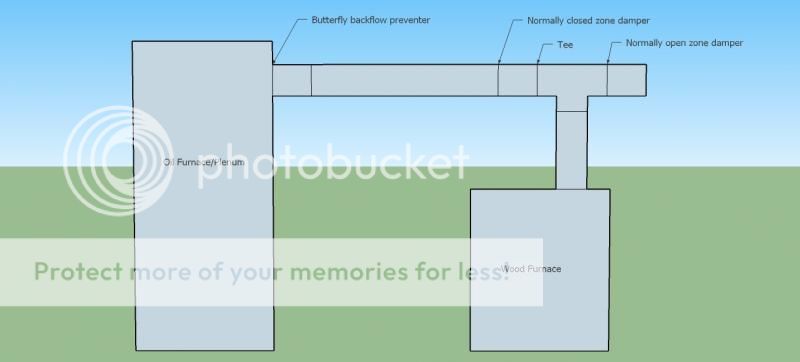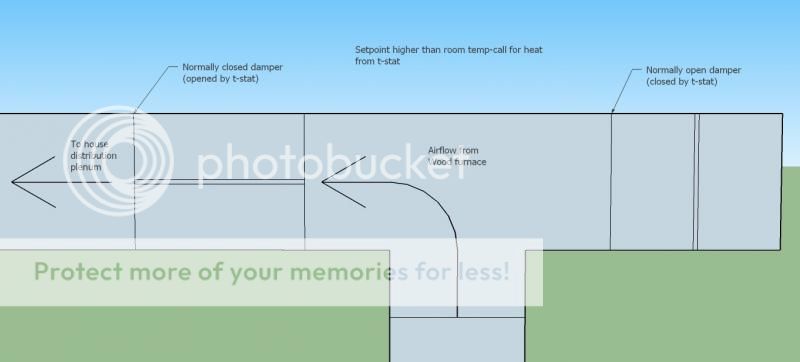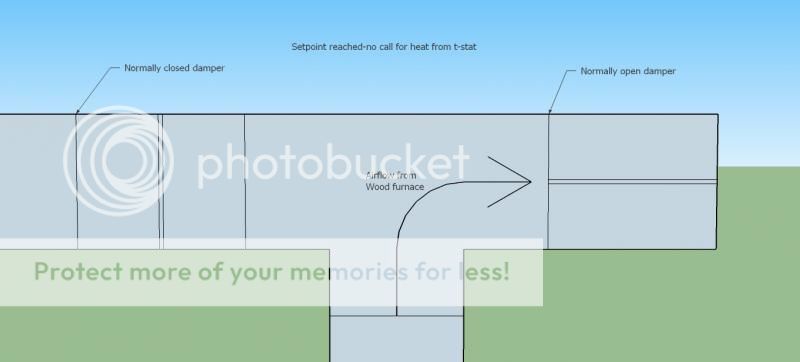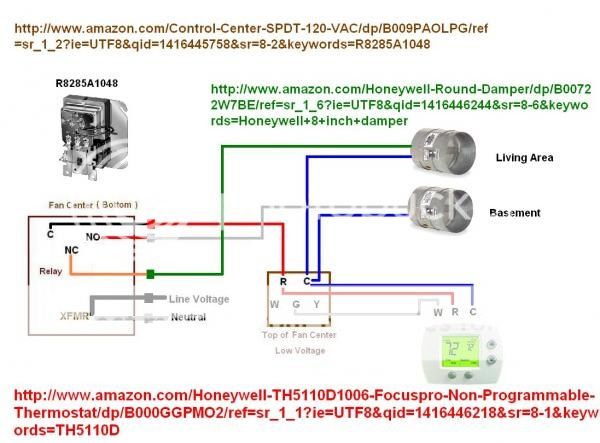- Oct 3, 2007
- 1,539
Managing comfortable temperatures in our small ranch with the Englander 28-3500 has always been a challenge. It's pretty easy to cook ourselves out of the house-especially at night when trying to strike the balance between an all-night burn and a reasonable bedroom temperature. I'm currently working toward completely redoing the ductwork in the house for this as well as a variety of other reasons, and I've come up with an idea for attempting to regulate the heat output (or at least the heat input to the house) from the Englander via a thermostat. Here goes:
A thermostat would be mounted on the wall next to the thermostat controlling the oil furnace. Just a simple, non-programmable one. Instead of controlling the blower on the Englander, the thermostat would control a power actuated damper like this one, which would be mounted inline with the duct delivering hot air from the Englander to my oil furnace plenum:

http://www.mcmaster.com/#2041k12/=umdicd
The thermostat and blower on the Englander would remain intact and operate completely independent of the power actuated damper. Operation would be as follows:
The Englander would operate as normal with the thermostat mounted on the back of the furnace controlling when the blower kicks on and off based on the temperature of the air jacket around the firebox (ie: on at 220 degrees/off at 190 degrees or thereabouts). The difference will be what happens with the heated air once it leaves the top of the furnace and enters the ductwork. If there is a call for heat from the upstairs thermostat, the actuated damper would be closed so that the heated air from the Englander enters the ductwork in the house, raising the air temperature. Once the setpoint has been reached, the damper would then open, dumping the heat into the basement until there's once again a call for heat, at which point the damper would close. I'm hoping that this will accomplish a few things:
A thermostat would be mounted on the wall next to the thermostat controlling the oil furnace. Just a simple, non-programmable one. Instead of controlling the blower on the Englander, the thermostat would control a power actuated damper like this one, which would be mounted inline with the duct delivering hot air from the Englander to my oil furnace plenum:

http://www.mcmaster.com/#2041k12/=umdicd
The thermostat and blower on the Englander would remain intact and operate completely independent of the power actuated damper. Operation would be as follows:
The Englander would operate as normal with the thermostat mounted on the back of the furnace controlling when the blower kicks on and off based on the temperature of the air jacket around the firebox (ie: on at 220 degrees/off at 190 degrees or thereabouts). The difference will be what happens with the heated air once it leaves the top of the furnace and enters the ductwork. If there is a call for heat from the upstairs thermostat, the actuated damper would be closed so that the heated air from the Englander enters the ductwork in the house, raising the air temperature. Once the setpoint has been reached, the damper would then open, dumping the heat into the basement until there's once again a call for heat, at which point the damper would close. I'm hoping that this will accomplish a few things:
- Make regulating the upstairs temperature easier (ie: Being able to keep the house at 70-72 degrees reliably).
- Provide a little extra warmth for the marginally insulated finished basement in the wintertime.
- Allow the Englander to run wide open-more efficiently and cleanly more often.
- Keep oil heat usage to a minimum during the shoulder season.


 When we were out of power for eight days after Sandy, I disconnected the furnace from the ductwork and just let it dump heat into the basement and though the house did not get as warm as usual, the wood floors felt very nice on our feet. Our house is definitely too small for the 28-3500, but I got it used for $300 six years ago from a member here when I didn't know nearly as much as I do now. Now I'm just trying to work with what I have and make it a little more "wife friendly."
When we were out of power for eight days after Sandy, I disconnected the furnace from the ductwork and just let it dump heat into the basement and though the house did not get as warm as usual, the wood floors felt very nice on our feet. Our house is definitely too small for the 28-3500, but I got it used for $300 six years ago from a member here when I didn't know nearly as much as I do now. Now I'm just trying to work with what I have and make it a little more "wife friendly." 


